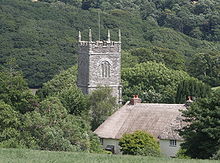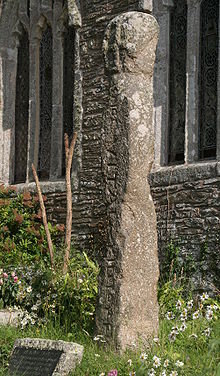- St Clement, Cornwall
-
Coordinates: 50°15′19″N 5°01′04″W / 50.2552°N 5.0178°W
St Clement (Cornish: Moresk) is a civil parish and village in Cornwall, United Kingdom. It is situated southeast of Truro in the valley of the Tresillian River. There is a smaller village at Malpas in the south of the parish. The urban part of the parish of St Clement was incorporated into Truro in 1895.
St Clement is attractive for tourists: aside from the natural beauty of the surrounding countryside they come to see the village church and its associated conservation projects that are maintained by members of the local community. Unlike some other villages in the district, the village of St Clement has changed very little in recent times.[citation needed]
Contents
History and antiquities
The old name of this place is Moresk and there was a castle here in Norman times. The manor of Moresk was one of the 17 Antiqua maneria of the Duchy of Cornwall. There was also an electoral ward of the former Kerrier District called Moresk. Malpas is nearer the Truro River: a road journey there means going via Truro (3.3 miles).
Parish church
The church is medieval but has lost much of its interest due to later restorations.[1] John Betjeman is less critical than Charles Henderson of the restoration of 1865 and remarks on the graveyard inscriptions.[2] The tower, in three stages, is built of slate and has a datestone for 1326 which corresponds to the style of building (however the third stage is of a later date). The rest of the church was decayed by the 1860s so most of the present fabric is from 1865 (however certain parts show genuine 13th-century work). The north transept has an arch matching the arcade of the south aisle (six bays in granite, nearly semi-circular arches and standard piers with elaborate capitals). There are two notable monuments: to Samuel Thomas (d. 1796), the work of John Bacon, 1799, has two allegorical figures; the other is to Rear-Admiral Robert Carthew Reynolds, from the studio of Micali, Livorno, and shows a young soldier and two women, the soldier points to a monument with a naval battle, above is the portrait medallion.[3][4] The battle is probably the engagement with the Droits de l'Homme. Captain Reynolds commanded the frigate Amazon in the Action of 13 January 1797 when, in company with HMS Indefatigable, the frigates engaged and drove ashore the much larger French ship of the line Droits de l'Homme. In the heavy storm in which the battle was fought, Amazon became unmanageable and was also wrecked, although the frigate was beached and all but six of her men survived, unlike her larger opponent which was run onto a sandbar and destroyed with hundreds of lives lost.[5]
- Cross in churchyard
The churchyard contains an inscribed stone cross: the first word of the inscription is perhaps isnioc (later opinion believes ignioc).[1] The inscription is "Ignioc Vitali fili Torrici" (i.e. Ignioc son of Vitalus son of Torricus) and the dating is 5th to 7th century. Another inscription is in Ogham, perhaps partly in Irish.[6] The inscriptions are both older than the carving of the upper part into a cross.[7]
Penair House
The house was built by Rear-Admiral Robert Carthew Reynolds (d. 1811) and was the residence of his son Barrington Reynolds. This house replaced an older one at least going back as far as the 17th century.[8]
Pencalenick House
The house which was built by J. P. St Aubyn in 1881 stands in historic parklands. The land around and including Calenick Creek has been designated an Area of Outstanding Natural Beauty.
Notable residents
- Francis Jenkins, Vicar of St Clement for over 50 years
- Sir Barrington Reynolds, Admiral in the Royal Navy
- Robert Carthew Reynolds, Rear-Admiral in the Royal Navy
Literary associations
Malpas ferry is associated with the legend of Iseult and Tristan as a point on Iseult's journey. W. J. Burley's Wycliffe and the Last Rites is set in a Cornish village called Moresk.
References
- ^ a b Cornish Church Guide (1925) Truro: Blackford; pp. 73-74
- ^ Betjeman, J. (ed.) (1968) Collins Pocket Guide to English Parish Churches: the South. London: Collins; p. 151
- ^ Pevsner, N. (1970) Cornwall; 2nd ed. Penguin Books; pp. 164-65
- ^ Mee, Arthur (1937) Cornwall: England's farthest south. London: Hodder & Stoughton; pp. 205-06
- ^ James, Vol. 2, p. 17
- ^ Pevsner (1970), p. 165
- ^ "Ignioc stone". UK Archaeology. http://www.ucl.ac.uk/archaeology/cisp/database/stone/sclem_1.html. Retrieved 5 December 2009.
- ^ Morgan, Claire. "Launce family of Penair". http://www.cornish-bloodlines.co.uk/html/launce_of_penair.html. Retrieved 15 December 2009.
External links
- Cornwall Record Office Online Catalogue for St Clement
- GENUKI website; St Clement
- Website for the Parishes of St Paul, Truro, St Clement, St George, Truro, and St John, Truro (united benefice)
Geography of Cornwall Unitary authorities Major settlements Bodmin • Bude • Callington • Camborne • Camelford • Falmouth • Fowey • Hayle • Helston • Launceston • Liskeard • Looe • Lostwithiel • Marazion • Newlyn • Newquay • Padstow • Par • Penryn • Penzance • Porthleven • Redruth • Saltash • St Austell • St Blazey • St Columb Major • St Ives • St Just-in-Penwith • St Mawes • Stratton • Torpoint • Truro • Wadebridge
See also: Civil parishes in CornwallRivers Topics History • Status debate • Flag • Culture • Places • People • The Duchy • Diocese • Politics • Hundreds/shires • Places of interest • full list...Civil parishes of Truro and Falmouth constituency  Chacewater • Cubert • Cuby • Falmouth • Feock • Gerrans • Gwennap • Kea • Kenwyn • Ladock • Mylor • Penryn • Perranarworthal • Perranzabuloe • Philleigh • Probus • Ruan Lanihorne • St Agnes • St Allen • St Clement • St Erme • St Just in Roseland • St Michael Penkevil • St Newlyn East • Tregony • Truro • VeryanCategories:
Chacewater • Cubert • Cuby • Falmouth • Feock • Gerrans • Gwennap • Kea • Kenwyn • Ladock • Mylor • Penryn • Perranarworthal • Perranzabuloe • Philleigh • Probus • Ruan Lanihorne • St Agnes • St Allen • St Clement • St Erme • St Just in Roseland • St Michael Penkevil • St Newlyn East • Tregony • Truro • VeryanCategories:- Villages in Cornwall
- Civil parishes in Cornwall
Wikimedia Foundation. 2010.


